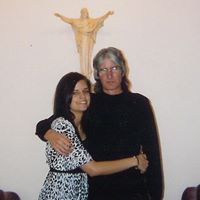Randy L Nash
age ~69
from Irondale, AL
- Also known as:
-
- Randy Lynn Nash
- Randy D Nash
Randy Nash Phones & Addresses
- Irondale, AL
- Grand Rapids, MI
- Marietta, GA
- Tucson, AZ
- 514 Roselle Ln, Birmingham, AL 35210 • 2059560797
Work
-
Position:Service Occupations
Education
-
Degree:High school graduate or higher
Us Patents
-
Feature Negotiation Protocol For A Synchronous Modem
view source -
US Patent:49532103, Aug 28, 1990
-
Filed:Feb 22, 1990
-
Appl. No.:7/483536
-
Inventors:Paul E. McGlynn - Decatur GA
Randy D. Nash - Dacula GA -
Assignee:Hayes Microcomputer Products, Inc. - Norcross GA
-
International Classification:H01B 138
-
US Classification:380 48
-
Abstract:A method for feature negotiations between two synchronous modems. To engage in negotiations a modem must be configured to support synchronous operation, a data transfer rate of at least 4800 bits per second, and at least one non-default feature. After the orginating modem and the answering modem have completed standard handshaking sequences the originating modem initiates the negotiations by sending a list of supported features. The answering modem responds by confirming that all the features are supported, by returning a subset of the features list, or by sending a different features list. If the answering modem did not confirm the list then the originating modem responds to the subset or to the different list by confirming the subset or different list, by returning a subset of the different list, or by sending another different list. If the originating modem does not initiate the negotiations, if the answering modem does not respond to the list sent by the originating modem, or if negotiations are not completed within a predetermined time after completion of the standard handshaking sequences, then the modems use standard (default) features.
-
Feature Negotiation Protocol And Dynamically Adjustable Retraining Sequence For A High Speed Half Duplex Modem
view source -
US Patent:49052829, Feb 27, 1990
-
Filed:Oct 19, 1988
-
Appl. No.:7/259882
-
Inventors:Paul E. McGlynn - Decatur GA
Randy D. Nash - Dacula GA -
Assignee:Hayes Microcomputer Products, Inc. - Norgross GA
-
International Classification:H01B 138
-
US Classification:380 48
-
Abstract:A feature negotiation protocol for synchronous operation and a dynamically adjustable retraining sequence. An originating modem, after completing conventional or standard handshaking sequences, sends a list of desired features to an answering modem. The answering modem either concurs with the desired features, if they are all supported, or sends, back to the originating modem, a list of those features which are supported by the answering modem. After the end of a negotiation time-out period, both modems begin operation using the features which are common to both modems or by using default (standard) features for operation. If the adjustable duration retraining sequence is selected then each modem will measure the elapsed time since the end of its last transmission and, at the beginning of its next transmission, send a retraining sequence which is dependent upon this elapsed time. Likewise, each modem will measure the amount of elapsed time since the end of its last reception and expect to receive a retraining sequence which is dependent upon this elapsed time. The adjustable duration retraining sequence generally operates to reduce the total retraining sequence and thereby increases the data throughput rate.
-
Autocorrelating 2400 Bps Handshake Sequence Detector
view source -
US Patent:48688649, Sep 19, 1989
-
Filed:Apr 1, 1988
-
Appl. No.:7/177534
-
Inventors:Taruna Tjahjadi - Norcross GA
Cynthia A. Panella - Alpharetta GA
Matthew F. Easley - Decatur GA
Randy D. Nash - Dacula GA
Steven R. Sweitzer - San Carlos CA
John N. Martin - Atlanta GA
German E. Correa - Marietta GA
George R. Thomas - Marietta GA -
Assignee:Hayes Microcomputer Products, Inc. - Norcross GA
-
International Classification:H04M 1100
-
US Classification:379 98
-
Abstract:An improved V. 22 bis 2400 bits per second (bps) handshake sequence detector. An incoming phase keyed (PSK) handshake sequence is autocorrelated using a frequency shift keyed (FSK) receiver (101). The autocorrelated signal is then filtered by a low pass filter (106). The autocorrelated, low pass filtered signal is then alternately fed, at a 1200 Hz rate, to two detectors (114,116). Each of the detectors (114,116) looks for one half of the handshake sequence. The output of each detector (114,116) is provided to an OR-gate (122). The 2400 bps handshake sequence is declared to be detected when either one or both of the detectors (114,116) detects its corresponding portion of the sequence.
-
High Speed Half Duplex Modem With Fast Turnaround Protocol
view source -
US Patent:48948470, Jan 16, 1990
-
Filed:May 26, 1987
-
Appl. No.:7/054419
-
Inventors:Taruna Tjahjadi - Duluth GA
German E. Correa - Alpharetta GA
Matthew F. Easley - Lilburn GA
John N. Martin - Atlanta GA
Charles H. McCorvey - Dunwoody GA
Randy D. Nash - Dacula GA
Cynthia A. Panella - Alpharetta GA
Michael L. Rubinstein - Atlanta GA
Martin H. Sauser - Atlanta GA
David F. Strawn - Marietta GA
George R. Thomas - Marietta GA -
Assignee:Hayes Microcomputer Products, Inc. - Norcross GA
-
International Classification:H04L 2300
-
US Classification:375121
-
Abstract:A modem with improved signal processing and handshaking capabilities as described. Two digital signal processors are used to perform independent, concurrent operations so that a faster execution rate is obtained and more precise calculations are made possible. The modem also uses an improved handshaking technique which allows the modem to maintain compatibility with existing 1200 and 2400 bps modems while allowing for negotiation for 4800 and 9600 bps communications. The modem also incorporates an improved baud clock recovery circuit which dynamically adjusts the actual sampling point in a manner dependent upon the difference between the actual sampling point and the optimal sampling point. This allows the actual sampling point to converge upon the desired sampling point at a high rate while minimizing jitter around the optimal sampling point.
-
Method And Apparatus For Providing For Automatic Gain Control Of Incoming Signals In A Modem
view source -
US Patent:50401947, Aug 13, 1991
-
Filed:Feb 9, 1989
-
Appl. No.:7/309209
-
Inventors:Taruna Tjahjadi - Norcross GA
Randy D. Nash - Dacula GA -
Assignee:Hayes Microcomputer Products, Inc. - Norcross GA
-
International Classification:H04L 2708
-
US Classification:375 98
-
Abstract:An improved circuit for providing automatic gain control (AGC) for incoming phase shift keyed (PSK) and quadrature amplitude modulated (QAM) signals. An absolute value circuit (193) and a comparator (195) provide a first error signal (197). An integrater (200,202) smoothes the first error signal (197) to provide a second error signal (201) to a variable-threshold threshold detector (204). The threshold (209) is initially set at a low value to allow the AGC circuit to quickly respond. A larger value is then used to reduce susceptibility to noise and provide for proper QAM operation. An error circuit (208,211,213) provides a non-linear response so that the gain variations will be small when the input signal (190) is large. This non-linear response further reduces the effects of noise on the AGC circuit.
-
High Performance Sigma Delta Based Analog Modem Front End
view source -
US Patent:49724363, Nov 20, 1990
-
Filed:Oct 14, 1988
-
Appl. No.:7/257733
-
Inventors:Raouf Y. Halim - Alpharetta GA
Randy D. Nash - Dacula GA -
Assignee:Hayes Microcomputer Products, Inc. - Norcross GA
-
International Classification:H04B 1406
-
US Classification:375 28
-
Abstract:An improved analog front end circuit for a high performance modem comprising an oversampling sigma delta modulator analog-to-digital converter which employs a novel four phase clocked MOSFET switched capacitor integrator. The integrator is switched in a manner as to eliminate signal dependent charges in the MOSFET switches. The sigma delta modulator shifts quantization noise of the analog-to-digital conversion process out of baseband of the analog signal. A novel integrated decimating FIR low pass filter filters the quantization noise from the digital output signals, and reduces the number of digital signals to obtain a sufficient number of signal samples in order to provide operation at high speeds, for example 9600 bps. The improved four phase switched capacitor integrator is also suitable for use in sigma delta modulator circuits, analog-to-digital converter circuits, integrating cirucits, and the like. A novel return-to-zero circuit eliminates distortion in a sigma delta modulator based analog-to-digital conversion process which can result from unequal rise and fall times of the digital output, by insuring that the energies in signals represented by a "one" and signals represented by a "zero" are equal, even during portions of the bit stream wherein there is a consecutive sequence of "ones".
-
Method And Apparatus For Generating Phase And Amplitude Modulated Signals
view source -
US Patent:49104748, Mar 20, 1990
-
Filed:Feb 9, 1989
-
Appl. No.:7/308815
-
Inventors:Taruna Tjahjadi - Duluth GA
Randy D. Nash - Dacula GA
Steven R. Sweitzer - Hillsborough CA -
Assignee:Hayes Microcomputer Products, Inc. - Norcross GA
-
International Classification:H03C 500
H03K 710 -
US Classification:332103
-
Abstract:An improved circuit for generating phase and amplitude modulated signals in a modem. A first circuit (161) generates a first signal (163) using a 1200 Hz carrier (160) and an input data stream (162). This signal (163) is generated at the rate of 7200 samples per second. The first signal (163) is then sampled by a sampler (164) at a 3600 Hz rate (165). The sampled signal (166) contains both a 1200 Hz signal and a 2400 Hz signal. A bandpass filter (43) selects a 1200 Hz or a 2400 Hz center frequency. The resulting output (44) is a selectable 1200 Hz or 2400 Hz signal which is generated using only the data sampling points necessary to generate the first, 1200 Hz signal (163).
-
Method And Apparatus For Generating A Data Sampling Clock Locked To A Baud Clock Contained In A Data Signal
view source -
US Patent:48497037, Jul 18, 1989
-
Filed:Apr 1, 1988
-
Appl. No.:7/176692
-
Inventors:Matthew F. Easley - Decatur GA
German E. Correa - Marietta GA
Randy D. Nash - Dacula GA
Cynthia A. Panella - Alpharetta GA
Taruna Tjahjadi - Norcross GA -
Assignee:Hayes Microcomputer Products, Inc. - Norcross GA
-
International Classification:H03K 117
H03K 700 -
US Classification:328 63
-
Abstract:An improved baud clock recovery, synchronization and data sampling circuit for a modem. A CODEC (41) samples the incoming signal at a rate determined by the sample clock output of a presettable counter (236). The sampled signal is then squared (231) and bandpass filtered (232) to provide a recovered baud clock. A detector (233) signals the positive going zero-crossing points of the recovered baud clock. A lead/lag calculator (234) determines which of the signal samples is nearest the zero-crossing point. The calculator (234) then determines whether this and every subsequent 12th sampling point leads or lags the zero-crossing point by inspecting the sign of the recovered baud clock and adjusts the preset inputs of the counter (236) to cause the sample points to occur at the zero-crossing point.
Name / Title
Company / Classification
Phones & Addresses
GGR, LLC
HOL-POINT, LLC
Resumes

Randy Nash
view source
Randy Nash
view source
Randy Nash
view sourceIndustry:
Machinery

Randy Nash
view source
Randy Nash
view source
Randy Nash
view source
Randy Nash
view sourceWork:
Tulare County Sheriff's Department
R
R

Randy Nash
view sourceSkills:
Editing
Microsoft Office
Powerpoint
Customer Service
Microsoft Word
Microsoft Excel
Teaching
English
Microsoft Office
Powerpoint
Customer Service
Microsoft Word
Microsoft Excel
Teaching
English
Googleplus

Randy Nash

Randy Nash

Randy Nash

Randy Nash

Randy Nash

Randy Nash

Randy Nash

Randy Nash
Youtube
Myspace
Plaxo

Nash, Randy
view sourceDublinOmnicare
Flickr
Classmates

Randy Nash
view sourceSchools:
Sequoyah High School Madisonville TN 2000-2004
Community:
Rhonda Garren

Randy Nash
view sourceSchools:
Fulton High School Knoxville TN 1982-1986
Community:
Jess Worthington, Tanyas White, William Witt, Charles Hux

Randy Nash
view sourceSchools:
Liberty-Eylau High School Texarkana TX 1996-2000
Community:
Sherry Crider, Sally Anderson

Randy Nash
view sourceSchools:
Fatima Academy St. Bride's Peru 1995-1999
Community:
Jennifer Duggan, Jason Mcgrath, Gertrude Lundrigan

Randy Nash
view sourceSchools:
Fatima Academy St. Bride's Peru 1995-1999
Community:
Jennifer Duggan, Jason Mcgrath, Gertrude Lundrigan

Randy Nash
view sourceSchools:
Amory High School Amory MS 1984-1989, Smithville High School Smithville MS 1985-1989
Community:
Mackey Otts

Randy Nash
view sourceSchools:
Pocono High School Mt. Pocono PA 1986-1990
Community:
Robert Nero, Ron Watson, Rick Spina, Lisa Spalla

Randy Nash
view sourceSchools:
William McKinley Elementary School Tulsa OK 1959-1963, Allen W. Roberts Elementary School New Providence NJ 1965-1968
Community:
Lisa Aigen, Hilary Jaeckel, Jesson Cowart, Bill Baynton, David Hoover

Randy Nash
view source
Randy Nash
view source
Randy Nash
view source
Randy Nash
view source
Randy Nash
view source
Randy Nash
view source
Randy Nash
view source
Randy Nash
view sourceGet Report for Randy L Nash from Irondale, AL, age ~69



















